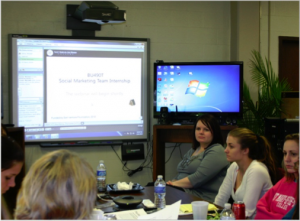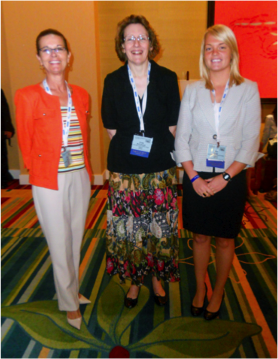
Campus students wait for the distance students to virtually join the very first meeting of the social marketing internship class.
Very few people can cheer on their son at a cross-country meet, while simultaneously discussing the pros and cons of Facebook marketing with a team of interns.
However, this was just another typical meeting for Jennifer Buell, development director for Catholic Charities. As a participant in Saint Mary-of-the-Woods College’s (SMWC) virtual social media marketing internship, Buell worked with students to reach out to a wider audience– without ever meeting face-to-face.
“The team did a very professional job,” Buell said, “We’ve been able to get a lot of information out on Facebook and have had a really positive response.”
In July 2010, SMWC received a $15,000 grant from the Ball Brothers Foundation to establish the internship. The College paired teams of campus and distance students with Wabash Valley not-for-profits to enhance their social media marketing. Not only did the students work virtually with each other, but they also worked virtually with the organizations, so people like Buell could meet with clients or focus on a fundraiser with as few interruptions as possible. At the end of the day, the experiment tackled a lot of what-ifs: Is it possible to make a significant impact in the community working virtually? More importantly, as an internship, would both sides, students and organizations, benefit from a virtual partnership?
By meeting virtually, the not-for-profits engaged with students when it worked best for them, not where. This flexibility bred the kind of convenience that not only saved the organizations time, but money, as well.
“They made the impossible, possible,” said Lynn Hughes ’08G, executive director of the Terre Haute Children’s Museum. “They used equipment owned by SMWC to keep our costs low, and did a lot of research on their own to minimize the time that we needed to spend with them.”
SMWC interns created a two-minute volunteer recruitment video for the children’s museum. The video, posted on the museum’s Facebook page and website, inspired various individuals to lend a hand. “Volunteering is vital for the museum because they have such a small staff,” said Cheyenne Plummer, graphic design major and museum intern.
As with many not-for-profits, a small staff must do big things, so a little help from the outside can go a long way. The Maple Center, for example, had its hands full providing clinical services to the Wabash Valley. The organization was in desperate need of a new website, but with pockets pinched, the project was put on the backburner. That is, until they saw the ad for SMWC’s virtual internship.
“As a small nonprofit, having students with expertise that we didn’t have was an incredible benefit,” said Melissa Dominguez Geib, the center’s executive director. The interns not only developed a website for the organization, but also created a user’s manual so that the project doesn’t end just because the semester did.
In order to guarantee longevity of their own project, interns working for Happiness Bag, Inc., also created a user’s manual to help the staff. “I was, and am, totally impressed by their organization,” said Cynthia McCullough, accounting major and intern for Happiness Bag. “They have a positive influence on so many lives.”
Along with a user’s manual, they also developed a website, an interactive calendar, and contact forms. “One student now volunteers to maintain our website,” said Jodi A. Moan, executive director of Happiness Bag. “We made an impact on her, too.”

Distance students Patti Jones, Cindy McCullough and campus student Erin Pugh present the results of the social marketing internship project at the Phi Beta Lambda Leadership Conference in Orlando, Fla.
Even though some students had little experience creating websites, their liberal arts education created a foundation where they could easily build these skills. Guided by expert professors and with access to state-of-the-art technology, these students were undaunted to accept a new challenge.
“Most businesses use different technologies to communicate all over the world,” said Jordan Bedella, business administration major. “It will be to my advantage that they see I know how to use it.”
The grant provided funds to create a web conferencing room, with touchscreen technology, a room camera, projector and large monitors to display group presentations. A high-end phone speaker facilitated conference calling and several mini web conferencing stations provided more intimate workspace. Using Adobe Connect Pro, recorded meetings were uploaded online. This innovative workspace helped the College bridge the gap between distance and campus students.
“Both distance and campus students have unique talents and can learn from each other,” Mitchell said. “It’s pairing the best of both worlds.”
The project’s mission was to help not-for-profits, while enlightening students with new techniques in collaboration, technology and developing their social consciences.
“We received very good feedback from the not-for-profits,” Mitchell said. “In some cases it was glowing.”
The Wabash Valley not-for-profits still reap the benefits of the virtual collaboration. From videos to websites, the word is out and only spreading faster.
“We were just thrilled with the work they did,” Geib said.
The students, many experiencing their own firsts, came away with new skills and the ability to work as a part of a team in any kind of environment.
“I can truly say it was a life-changing experience,” McCullough said. “The benefits have far surpassed the work it took to do this first-class project.”
